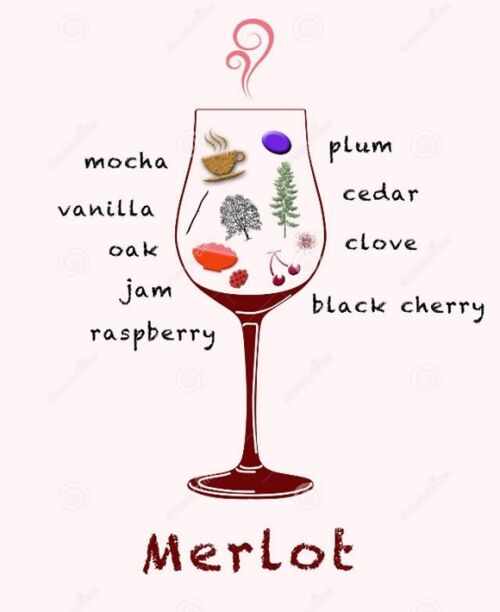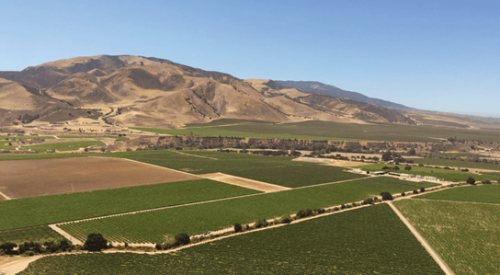By Nick Adams MW
Merlot is often the dancing partner with Cabernet Sauvignon, as epitomised in the Left Bank wines of Bordeaux. Move to the Right Bank of Bordeaux then Merlot dominates all the main blends and wine regions - most especially so in the AOCs of Pomerol and St. Émilion. And here the top wines command higher prices than any other in the whole of Bordeaux.
Pictured right: Châteaux Le Pin and Petrus in Pomerol - Merlot at £3,000-£5,000 per bottle …. Now back to the real world …
However, Merlot produces an array of wine styles and at all prices. Countries such as Chile and America, as well as the South of France, have taken to the variety and make highly accessible and affordable wines.

Overall, Merlot is a grower’s favourite, and too for many consumers, as it hits so many buttons in terms of aromas, flavours, texture, and styles which make for very enjoyable drinking.

Along with Cabernet Sauvignon, Merlot is the world’s most widely planted black grape. It is believed to have got its name from the French word for the blackbird – merle – as the grape colour was the same as the bird’s plumage. What makes it attractive to growers is that it is relatively early ripening (by that 2-3 weeks earlier than Cabernet Sauvignon), is relatively disease resistant, and crops well (too well maybe for greedy producers). It produces a “fleshy”, juicy style of wine, with bright black and plum fruit and is not too acidic or tannic – so not unsurprisingly consumers take to it.
The University of California Davis has confirmed that Merlot was related to Cabernet Franc (itself the father of Cabernet Sauvignon) and closely related to Carmenère too. So, no wonder all these varieties were interlinked in the general red wine landscape of Bordeaux. And the Carmenère link had ramifications too for Chile.
Chile’s wine heritage has strong links to Bordeaux and even to this day most of the red wine produced revolves around Bordeaux varieties – either as individual varietal wines or in blends. And for a good part of the 20th century a lot of what was thought to be Merlot, was in fact Carmenère – and labelled as such. This was an understandable error given the close DNA relationship of the grapes and the style of wines they both produced. Today both varieties do very well for the country and Chile has become home to arguably the best value for money Merlots in the world – possibly only rivaled by the those from the vast Vin de Pays d’Oc swathe in the south of France. And please find two examples of really great value for money with easy drinking soft and juicy fruit expressions of the grape. Wines to pour both by the glass and with lighter red meat and bold vegetarian foods.
Chile vs South of France
Back to Right Bank Bordeaux, and to be fair to Merlot very good examples can still be found here and at sensible prices - Peter Graham have a fine selection of these. Drop down from the heady heights of Le Pin and Petrus and you still find top notch Pomerol and even Grand Cru St. Émilion of real style and quality which express the Bordeaux take on Merlot perfectly. Both the examples below showcase the blush, rounded plum fruit notes and fine texture and mouthfeel.
Pomerol & St. Emilion
Other important areas for Merlot
Italy
Large swathes of northeast Veneto vineyards are planted with Merlot which make in most cases solid, workhorse wines, although wines from the cooler lower Alps areas to the north can be more refined. The highest quality examples - and again with a price I’m afraid are from the coastal Tuscan region of Bolgheri. Head down south and plantings are increasing - such as in Puglia and Sicily and these take on the heat of the region to give the wines an even juicer take and mouthfeel. A good example of this is the appassimento take below where the Merlot grapes have been partially dried before fermentation to increase the richness and depth of flavour in the finished wine.
California
Merlot is also grown quite widely in Washington State to the north, but it is California where the variety is most important and widely planted. Here you get the whole range of styles produced from the soft, juicy, and jammy wines of the hot Central Valley to the refined and structured, if still rich, styles of Napa, Sonoma, and Santa Cruz in particular. There are fewer pure 100% Merlot examples; it is most consistently used in Bordeaux blends (where Cabernet Sauvignon takes the lead) – these are sometimes referred to a “Meritage” wines or blends.
A lovely example of a pure Californian Merlot is the Wente one from the Livermore Valley (pictured left) - this has a fine texture as well as ripeness of black fruit.
South Africa
The spiritual home for Merlot (and Cabernet Sauvignon) in South Africa is without question Stellenbosch. Again, many are made from blends of the two, but the Peacock Ridge wine is pure Merlot and showcases the almost dark chocolate touch (as well as cassis fruit) that you can find in some New World example.

Merlot Styles
Merlot’s positioning on a Wine List
One of the many things I like about Merlot - apart from its aromas and flavours of course in good examples - is its adaptability and flexibility. Because of its structural attributes - by that medium body, acidity, and tannins - it has the capacity to please a broad spectrum of wine drinkers’ tastes. The black and red fruit, and plum flavours are simply appealing; and it takes well to oak if you want that layer of spice, toast, and vanilla - equally unoaked examples are vibrantly fruity and open.
Lighter examples can be sold by the glass, whilst richer ones are perfect match with a range of foods - obvolute red meats and game, but also weightier maybe roasted vegetarian dishes. It also works well with curry as a grape! It is a serious consideration for any professional wine list for sure.


